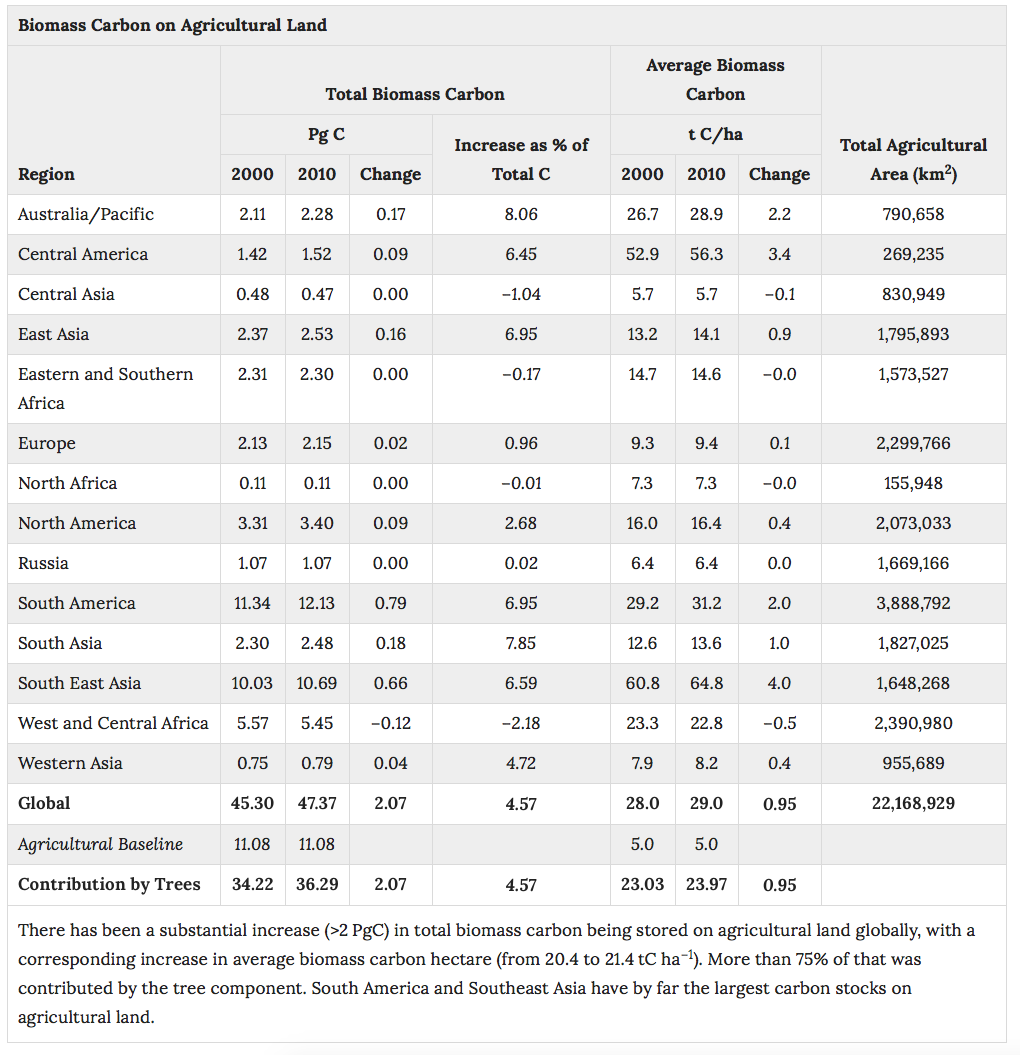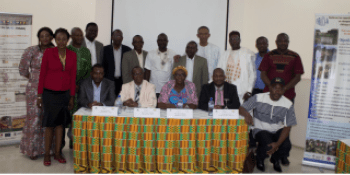Climate change mitigation from agroforestry estimated

Tree cover contributes significantly more to carbon pool on agricultural lands than estimated.
In a global analysis of tree cover on agricultural lands using remote sensing data, leading agroforestry scientists found the total biomass of carbon on agricultural lands to be four times higher than Intergovernmental Panel on Climate Change (IPCC) default values, with trees contributing 75% of the biomass carbon.
These results show that existing tree cover - thus far ignored in most global and regional calculations - makes a major contribution to the carbon pool on agricultural lands. Consequently, a substantial and significant correction on current estimates based upon IPCC default values is warranted." Zomer RJ et al. in Global Tree Cover and Biomass Carbon on Agricultural Land: The contribution of agroforestry to global and national carbon budgets.
The authors collected and analyzed data at the global, regional, and country levels to account for variations in tree cover and biomass carbon on agricultural land, including whether the agroforestry resources are stable. The full dataset is available from the World Agroforestry Center (ICRAF).
Table 1 from Zomer et al. shows total biomass carbon on agricultural land (in petagrams of carbon, which is equivalent to gigatonnes of carbon; and as a percentage of the total biomass carbon in 2000) and average biomass carbon (in tonnes of carbon per hectare) in the years 2000 and 2010 in regions and globally. Their calculations of the contribution by trees to biomass carbon on agricultural land is on the last row.
Agroforestry benefits for smallholder farmers
Agroforestry may offer both climate change mitigation and adaptation benefits to smallholder farmers. Scientists found that the amount of biomass carbon sequestered by trees on farms increased between 2000 and 2010 in many countries, and is generally much higher than estimated. As smallholder farmers increasingly access the opportunity to benefit from climate finance projects, mitigation through agroforestry may offer financial incentives.
In addition to income from mitigation and from the production and sale of agroforestry products, trees on farms are a critical component of climate-smart agriculture in many systems. Trees regulate moisture – moderating drought or heavy precipitation – and soil temperature. Trees contribute to soil fertility by adding nutrients – in the case of nitrogen-fixing species, for example – and they contribute to increasing soil organic matter.
Increasing biomass carbon on agricultural lands through agroforestry may also improve biodiversity, water quality, and, in some cases, hydrological cycles.
Recommendations
Analysis unveiled regional, national, and sub-national patterns of growth and decline in agroforestry, but further research is required to identify the drivers of such patterns. Investigation, identification, and development of locally relevant policies and market mechanisms that reduce forest conversion, increase carbon sequestration on agricultural lands, and improve the livelihoods of local peoples are also needed.
The results of our spatial analysis show that trees on agricultural land sequestered close to 0.75 Gigatonnes of carbon dioxide globally per year over the past decade," said Henry Neufeldt, co-author and head of climate change research at the World Agroforestry Centre and a CCAFS contact point. He added:
If we can harness good policies to enhance positive examples and stop negative trends, trees in agricultural landscapes can play a major role in greenhouse gas mitigation. But no one should say that this is already solving the problem for agricultural emissions as long as we do not know what is actually happening on the ground.
In the context of the United Nations Framework Convention on Climate Change (UNFCCC) processes and the Paris Agreement, researchers recommend including biomass carbon in global and national carbon monitoring protocols.
Read more
- Journal article: Zomer RJ, Neufeldt H, Xu J, Ahrendts A, Bossio D, Trabucco A, van Noordwijk M, Wang M. 2016. Global tree cover and biomass carbon on agricultural land: The contribution of agroforestry to global and national carbon budgets. Scientific Reports 6: 29987.
- Dataset: Global tree cover and biomass carbon on agricultural land. World Agroforestry Centre.
- Blog: Trees on farms: the missing link in carbon accounting. World Agroforestry Centre.
- SAMPLES website. Standard Assessment of Agricultural Mitigation Potential and Livelihoods (SAMPLES) aims to improve data on agricultural greenhouse gas emissions and mitigation potentials by providing reliable emissions information from agriculture in developing countries.
- Kuyah S, Mbow C, Sileshi GW, van Noordwijk M, Tully KL, Rosenstock TS. Quantifying tree biomass carbon stocks and fluxes in agricultural landscapes. In SAMPLES: Standard Assessment of Agricultural Mitigation Potential and Livelihoods. CGIAR Research Program on Climate Change, Agriculture, and Food Security.
- Recent research on quantifying agricultural emissions.
Julianna White, author of the blog, is program manager for CCAFS low emissions agriculture research.
The journal article acknowledged: the National Key Basic Research Program of China, thr National Science Foundation China, the CGIAR Research Programs on Forests, Trees and Agroforestry and the CGIAR Research Program on Climate Change, Agriculture, and Food Security, the Carbon Dioxide Information Analysis Center (CDIAC) Oakridge National Laboratory, and authors of “New IPCC Tier 1 Global Biomass Carbon Map.”




